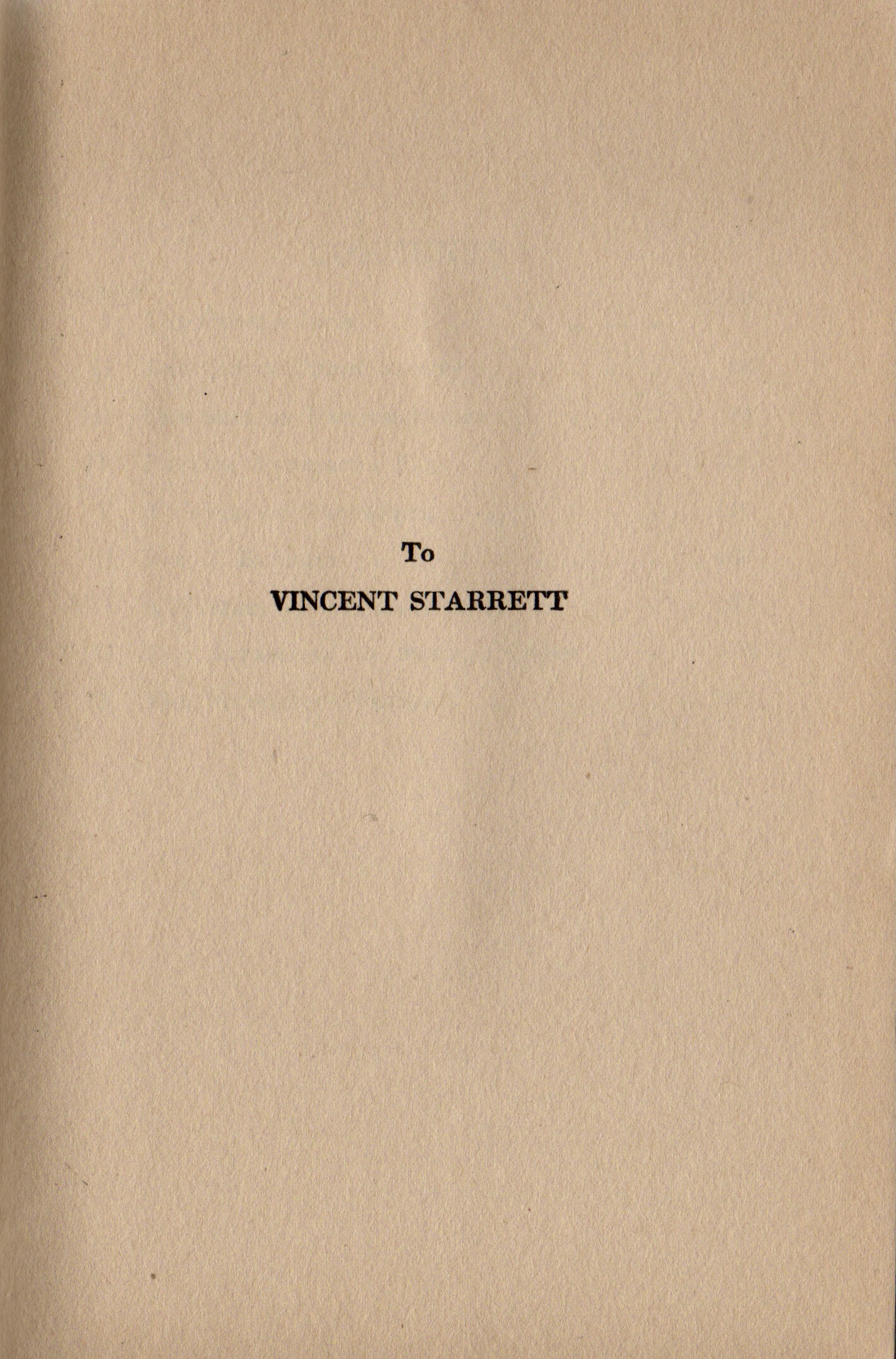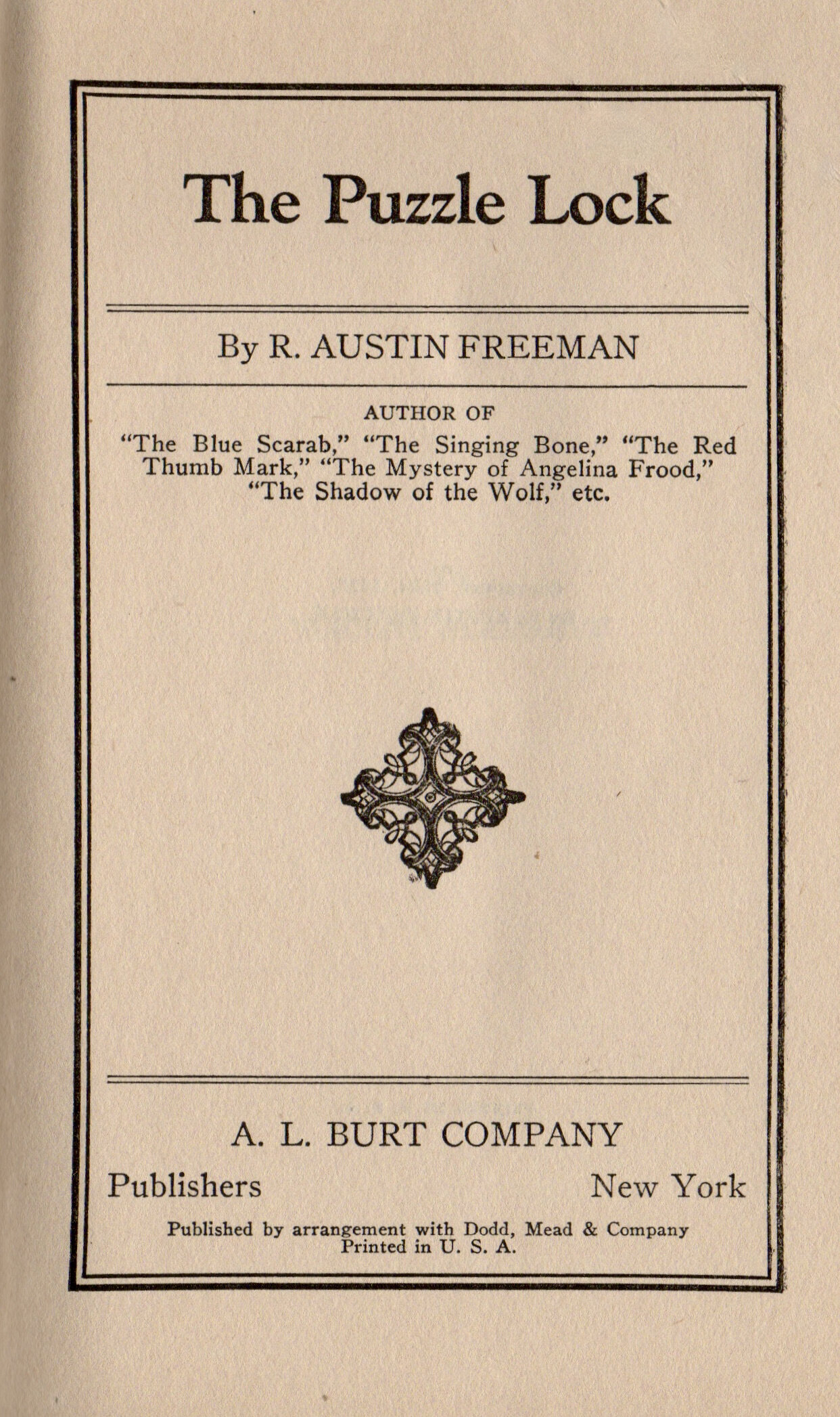Starrett steps into the world of Dr. Thorndyke
Why did R. Austin Freeman dedicate a book of mysteries to Vincent Starrett?
When a friend gives you a book, it is an occasion to be treasured. So when Steve Rothman quite generously passed along a copy of R. Austin Freeman’s anthology, The Puzzle Lock, I was touched. It was especially generous because the book is tough to find. It also has a nice association to my passion for all things Vincent Starrett: Freeman dedicated the book to Starrett. How this came to be, and the relationship between the men over the years, is worth a few minutes of your time.
Pull up a chair and pour yourself something warm and comforting. This will be a cozy story.
If there was one detective who rivaled the popularity of Sherlock Holmes in the early decades of the last century, it was R. Austin Freeman’s Dr. Thorndyke. Like his creator, Thorndyke was a physician and a scientist. And like Holmes, Thorndyke used science to build a case for bringing miscreants to justice.
Title page to the Modern Library edition of Fourteen Great Detective Stories, edited and with an introduction, by Starrett.
Arthur Conan Doyle often defended his plots for their plausibility. Freeman took things one step further, building his own laboratory and testing the science behind his clues and Thorndyke’s deductions. His lab was the real-life equivalent of his creation’s own laboratory in the upper story of the detective’s rooms at 5A King's Bench Walk, Inner Temple.
There are numerous parallels between Holmes and Thorndyke. So it was no surprise to learn that Vincent Starrett was a fan of Thorndyke, “who stood second only to Sherlock Holmes in my pantheon of detectives” as he acknowledged in his memoirs. And, as he did with Arthur Conan Doyle, Starrett wrote to Thorndyke’s creator to introduce himself as a collector and a fan. There is a file in the library archives of Kent State University that shows a series of letters sent to Starrett from Freeman in response to the Chicago man’s questions. Freeman even sent Starrett copies of his books. For example, the earliest letter in the Kent collection dates from 1920 and “Lists his (Freeman’s) books which feature John Thorndyke; sends several books to him (Starrett).”
That’s one way to build a book collection.
BTW, it is worth noting that the Kent State library shows that Starrett sent Freeman a copy of “The Unique Hamlet,” for which Freeman was grateful. It’s nice to know the shipment of publications went both ways between the two men.
Starrett traveled to London in the autumn of 1924 in part to make amends with Arthur Machen over a dispute involving Machen’s literary representation in the United States, an issue which will be the subject of a post later this year. While in Holmes’ city, Starrett visited several other writers he fancied, including Freeman. Here’s how he recounts the visit in Born in a Bookshop.
“I took him by surprise, I am afraid, and interrupted an afternoon of work; but for an hour we chatted over coffee and ultimately I was permitted to see, nay to explore, the famous top floor laboratory. Yes, there I was, if you will believe me, in Thorndyke’s very rooms.”

Note that construction. Starrett does not say he was Freeman’s laboratory. No, he was in Thorndyke’s lab.
The awe in Starrett’s description is clear. It would be the equivalent of walking into a set of rooms in Baker Street and finding everything as Dr. Watson had described. Starrett, who was never far from what we would call today a “fanboy,” was in heaven.
The meeting and correspondence must have had a favorable impact on Freeman as well. In 1926 he dedicated The Puzzle Lock, a collection of his Thorndyke mysteries to Starrett.
Starrett was deeply pleased, as he noted in his “Books Alive” column on Oct. 10, 1943. He was eulogizing Freemen, who had just passed away and noted that,
“When the doctor dedicated his book, The Puzzle Lock to me, I acquired delusions of importance that must have been very trying to my friends. (But I shall mention it here if it is the last thing I do.)”
A few years later, Starrett included one of Thorndyke’s adventures in a Modern Library anthology. 14 Great Detective Stories featuring Starrett’s introduction became a staple of the Modern Library for decades. Speaking as both a fan and a writer of detective stories, Starrett considers what a nasty place London was with its corps of amateur detectives “smoking pipes in queer lodgings and solving bizarre mysteries in slippered ease; whimsical philosophers, deducting a Helen from a hairpin, their ironic languor broken by bursts of demonic enterprise—largely at the solicitation of baffled operatives of the regular force.”
The dust jacket for a later Modern Library edition featuring a Dr. Thorndyke tale selected and introduced by Vincent Starrett.
Starrett selected “The Case of Oscar Brodski” to represent Freeman’s detective for this collection, and it's easy to see why. The tale is typical Thorndyke, with the reader watching as the crime is committed in the first chapter, “The Mechanism of Crime.” We then get to watch in the second chapter, “The Mechanism of Detection,” as Thorndyke’s friend and frequent chronicler Dr. Christopher Jervis, describes how the detective slowly and methodically follows the evidence until the murderer’s identity is made clear.
This inversion of the plot, with the reader knowing who the guilty party is from the start, is what many of us now think of as the “Columbo” technique. This was Freeman’s signature move and became as much a part of a Thorndyke story as his traveling laboratory or “the box of magic,” as a character in this story names it.
“The reader has seen the crime committed,” Freeman once explained, “and is in possession of all the facts. It might seem that there is nothing left to tell. But I calculated that the reader would be so occupied with the crime that he would overlook the evidence; and so it turned out. The second part, describing the investigation of the crime, had to most readers the effect of new matter. All the facts were known; but their evidential quality had not been recognized.”
It was a formula Freeman would use for decades.
Starrett returned to Freeman and Thorndyke decades later when he edited and introduced the first six books in the Seagull Library of Mystery and Suspense series. The Singing Bone was published in 1965 and features classic Thorndyke tales. While they had slowly faded from popularity in the intervening years, Starrett still believed Freeman’s work represented the best of its era.
An odd dust jacket, designed by Larry Lurin.
“Few writers of our time are more deserving of our gratitude than Dr. Freeman for honest entertainment in an important field of make-believe. John Evelyn Thorndyke, M.D. F.R.C.P., was the first authentic scientific fathomer in detective fiction, an investigator who would not believe black was black until he personally had found it so. Whatever the perils and upsets that beset his way to a solution, his triumphs ultimately were won in the laboratory, and his science was sound.”
Starrett even recalled the praise of his old Irregular friend Christopher Morley:
“Not to know Dr. Thorndyke is not to know perhaps the most carefully established crime savant since Sherlock Holmes. I admit to a considerable affection for R. Austin Freeman’s tales. He is an ace in these matters; you feel safe in his hands. Whenever you are in doubt, stick to Dr. Thorndyke.”
You can find modern editions of Freeman’s works about Thorndyke pretty easily these days, both in digital and print versions. And if you want to dive deeper into the world of the good doctor, let me recommend In Search of Dr. Thorndyke by Norman Donaldson. It contains a bibliography of Thorndyke first appearances, the stories behind the detective’s evolution, a good biography of the author and other details.
The dedication to In Search of Dr. Thorndyke.
Donaldson’s book was published in 1971, and he had interviewed Starrett the year before while doing research in Chicago. Starrett “was not only a gracious host but, by sharing his personal memories of Freeman and passing on to me copies of their correspondence, helped enormously to my understanding of Freeman’s activities in the twenties.” There are a number of other references to Starrett in Donaldson’s book.
I suppose it was only right then that Donaldson would dedicate his book to Starrett and another Baker Street Irregular, P.M. Stone, who did quite a bit of research of his own into Freeman’s writings.
The cover to an edition of 14 Great Detective Stories, edited by Starrett.
Personally, I’ve found Freeman’s work goes best with a glass of liquid refreshment nearby. His writing style is dry and, like his detective, more concerned with facts than characterization.
So let us have a refill, and pull down another volume of Dr. Thorndyke, preferably with a Vincent Starrett introduction.
Cheers.


